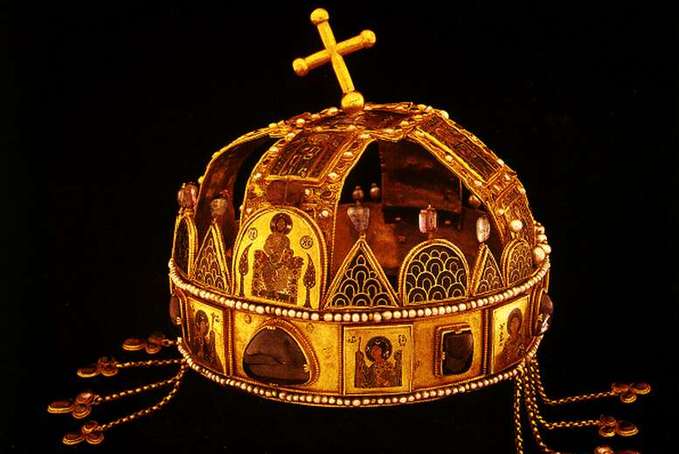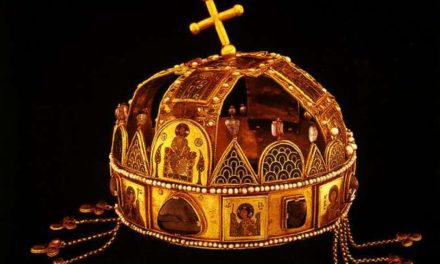The story of the Hungarian Holy Crown is not simply about a coronation badge, as it is much more than that, it is also the story of the preservation of the Hungarian nation, the mystical relationship between Hungarians and the Holy Virgin. Our series follows the history of the Holy Crown, not forgetting its symbolic role.
Who are you, bright star of the old world
In a dark fog? The night of hundreds
It rests on you: yet it is burning
Your image radiates among us.
(Dániel Berzsenyi: The first stanza of his poem Lajos Nagy and Mátyás Hunyadi, 1800.)
as an insignia and symbol of divinely derived royal dignity and power, it is made of gold . a structure embodying a system consisting of a lower tire and an upper cross strap, a golden cross at the top, nineteen enamel images, jewels, true pearls, folded gold wires patterning tendril ornaments, nine pendants, pearl wires, organically connected to each other in its elements, bearing multilayered meanings .
For the coronation of the kings of Hungary, according to the old popular belief, first King St. István, who conveyed divine power and thereby determined the purpose and purpose of the power (historically from a time that cannot be precisely determined), the actual royal dignity, power and the sacred power required for the crown were given to the person to be crowned the so-called closed tire crown, which is handed over during the coronation ceremony, which includes placing it on the head according to a specific sacred order, and is therefore inaugurated, is typically used once in the life of a monarch, during the coronation - and only exceptionally more than once - which is essentially in its currently known form (apart from certain changes in shape resulting from mechanical damage and some rear from the supposed exchange of his enamel pictures) embodied the completeness of the main power of the country, represented the source of all rights, the country itself.
the name " Holy Crown of Hungary " (Sacra Corona Regni Hungariae) is that the country - not the king subject to the crown - has a crown, and the most accurate meaning is the way it should have been understood in reality, in public law practice: The Holy Crown, - as the main power , a special state personality - had a country according to the essence of the doctrine of the Holy Crown.
The Holy Crown has a mystery. Respect for the crown does not merely and exclusively reflect rational considerations, just as no tradition or highly respected value, custom or rule of conduct can be built solely on the building blocks of reason and discretion. Respect is, on the one hand, religious and, on the other hand, secular, made up of elements integrated into high education, i.e. belonging to folk tales and folk religiosity.
The community's collective unconscious, forgotten memories and experiences, desires and feelings are included, as are the ways of acting, behaving, and human-political games determined by everyday political and interest struggles. In Greek, mystery means both a mysterious ceremony, a certain inspired state of mind and a purified mood, the "filling of the inner".
The Holy Crown is of truly mysterious origin, the object that plays the main role in a symbolic ceremony, the guiding public law doctrine and idea that determines orientation in national public affairs, the feeling and awareness of the orderliness of public affairs for the members of the country, legitimacy itself.
The mystery of the Holy Crown, i.e. not its myth, but its mythic system and secrets, has at least two, basically outside the law, beyond (metajuristic) areas. One is the Holy Crown itself as an object, the other is the Regnum Marianum. Both connections are also myths. Without these, we cannot understand or experience the doctrine of the Holy Crown, which requires experience, emotional involvement, and kinship. Anyone who does not want or cannot approach the Tan with a kindred spirit will not understand it. Somewhere here you can also find the opening of debates and disagreements.
(To be continued)












